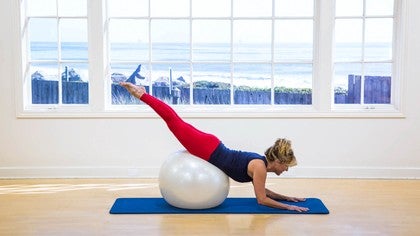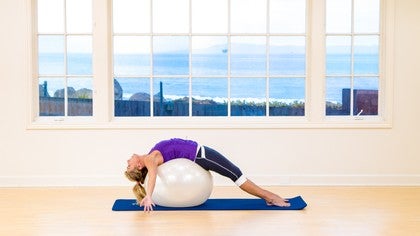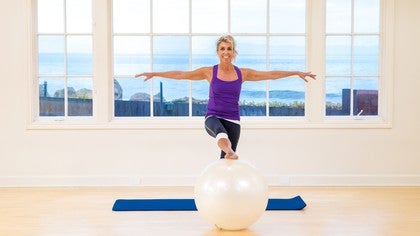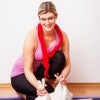Description
About This Video
Transcript
Read Full Transcript
Okay, grab a ball. Um, I think this is a 65 centimeter ball, slightly deflated. That's just what happens over time. So it's, it's not the largest. It could be, but I don't think it's quite as small as a 55 centimeter. But basically we're going to use it at least in the beginning for balance playing a little bit. So take your ball, make sure that when you sit on it, which is what we're going to start with, that you aren't so low to the ground, that you're really flexed a lot more than 90 degrees. Make sure that the ball securely blown up all of that. I'm going to turn sideways because this is the fun part. Are you going to do for now is balance and decide what you want about it.
But I do it for a couple of reasons. One, if I sit up straight, which you will, we will. Um, it just requires all those little muscles around the spine that just kinda say hello. Okay, we're here now. Um, even if you've been sitting all day, all these muscles are kind of having to react to even the simple motion. So have fun with it. You can kind of play, you get crazy. I'm going to come back to you. Keep going. It's kind of small but just enough that all those postural muscles are kicking in. Then mellow it out a little bit. Cause what we're going to take it into is lifting a leg.
You may need your arm then put my now just lift one leg, a few little bounces, put your foot down. Other leg, just lifting, coming, just tapping in. There's lots of ways to kind of check in with where we are. I'm still not sure. Full flex down. I will not ask you to pick up both legs, I promise. But I will ask you to kind of pick up one and then the other at whatever pace you want. Just sort of seeing where at. Oh I can see where I want to fall too. But I want, cause I'm not going to get that nets just yet.
It's tapping into balance, right? Anyone walks by and looks, I was like, oh, so that's bloodies. Yup, no it's not, but what is, all right. Put your feet down now and then from there just separate and wide. I'll move sideways again, separating. I'm basically parallel little turned out of the fetus. Fine.
And then just start a gentle rocking motion so you know where you are in your ball from there, ground yourself where you, your feet are flat and stable and then just start to round your back, right? You don't want to go so far back, of course, that you feel you're going to fall. If you do, you just sort of lean forward, get this looseness through the back, hold on to the knees or just brace yourself a little and roll back to neutral. But also let a little bit of an arch. I'm using my legs a little just so I'm still on the ball, right? But I'm not, it's not about the leg frustrating or bending.
It's so that I can get the curve in the back now and then passing through neutral. Not necessarily widening the legs a lot more, but maybe some not. And rounding and then as you get used to it, start minimizing how much you use the legs in terms of where you are on the ball. Just let yourself round. You're not collapsing, you're lifting and yes, your ribs are opening. It's okay as long as you're not letting everything go right. And what I mean by that, you've rounded when you pass through middle kind of, if your hands are just inside the knees, like minor, lightly, press the knees in just a little, you don't have to see it and then hold through the pelvis and abdominal section even as you go into upper back extension. If I were completely letting go, I can let everything just sorta dump out. Let's avoid that and do a couple more rounding back everything and arching without throwing the hipbones forward. Last one. Rounding back and is waking up the spine and while we're here, find a neutral place and let's just swing the hips into a circle and by swing, let's just take it to the adolescence to the right.
Now let's try to keep the upper body pretty still, just getting used to where we are. And then have some fun with it. Make a circle. So I'm tucking, I'm rounding, I'm going over to the right. I'm allowing that archery just pass through. I'm going to the left. Keep going. When you get used to it, you can let the upper body go bit. But again, just trying to feel the differences in that separation that we could have between the upper and lower. Go the other way. Circle it around. Ah, sometimes you just need to loosen up to know where you're going next or to want to even go there. That's sort of what's happening here, but something I do at home. All right, let's start by standing up now.
Still kind of thinking in terms of using the ball for balance. Um, keep the ball near. I know there's tricks to keeping it totally stable, but I tend to just hold it. We're just gonna have our hands on the ball without shifting your hips back a whole lot more. Just rounded down. Start to push the ball away and then gradually let your back flat now. Okay. Then you can adjust for where you want your hands. I like the Andrew result from my hands to be stable, so I don't feel like it's just my fingertips.
I could use it for support and I don't feel like I'm the ball so far away that I'm hanging on my shoulder joint. From there. Inhale, exhale, start to scoop the belly and just roll the bell back toward you and then go back out again. Unfurling the spine, elongating it, reached the tailbone backwards as the head goes forward to the ball and exhale, bringing it back.
But I recommend not without leaning the ones I take that left leg and start to slide it back. Right. That's it. Both legs are still straight back, hopefully is still straight. And then bring it back in. Shift the weight. You're going to just switch sides and try to keep the ball still. Just notice what you notice and bring it back. All right? You could do this with the ball. I'm up against a wall. If you don't want to be bent over like this
Or where do I need to hold on and by, hold on. I don't mean not wobble. I gave up not being wobbly long time ago. Take the first leg back again. Now I am going to ask you to lift the leg if you're up for it. If you're not, just hang out. Otherwise you lift and, oh, I would not rely on that ball a lot and let the net be high just to lift and down. You're doing this yourself, right? Not doing it to punish yourself. You're doing it to see where you're at. You're doing it to see what you're capable of or what you need to take care of.
You're too wobbly and it's no fun. Stop it. But practice something a little easier like against the wall. That's it. Switch sides. So take your time. If you need to come up for air, do it. Otherwise, I'm assuming your breathing slide the other leg back first. This is the second leg. And when you're ready, if you're ready, lift up
That would have been smart. I didn't. If you have one near you or a wall [inaudible] you might be able to grab it. Um, but we're going to make those circles you've seen me and Meredith do before. Together we're tall this time we do want you to think about how you have level hips, whatever you have to do with your arms, you just extend the leg out. No big deal. And, and I'm not trying to push on the ball, I'm trying to just, it's actually helping me in, in the small way to stay up. Okay.
And again, if you're fancy or wanna be, as you extend that, like that's on the ball. You could rise up on [inaudible] or onto the toes. You're not going to see me doing that today. I've done it.
Other leg up. I'm also, by the way, trying not to turn my lower leg out a lot, maybe a tiny bit. And I obviously want to be safe, but I'm not gonna make this wide basis support on the bottom or it sorta defeats the purpose. Here we go, harass it out or stretch it out and bring it back. Trying not to hike the hips and back. If it's so easy, you can Relevate. You could do it on a disc. Go crazy, right? Fornas is to, yes, challenge yourself and maybe have a little fun, but let's not be unsafe for the sake of tricks. All right, I'm going back to the first leg and I'm just going to face you so it makes more sense. If my words don't, same start, but if we extended it out all the way, it'd be really hard to do it. We're going to do so you can keep a little bit of a knee band and then just try to make a full circle. However, no perfect placement of the feet, Chester. Sure you could do the whole Relevate thing again.
Okay. Switch feet. The fun part is doing this at different times of the day. I often work out late, here we go. We just press it out. Maybe not fully extended. Pick a direction and make your circle and sometimes it's easier later at night when the day is over
Once you've done your two, two and a half, go the other way. It's the middle of the day, which is right now. That's hard. But all the more reason for doing it. Alright, that's gonna do it for that. Okay. So let's continue with this idea of using the ball, um, which ultimately balance and loosening up, right? So come down to the floor or your mat with your knees and give yourself a little room in front of you so that you can stretch the ball and your arms out away from you. Similar to what we did standing [inaudible].
We're going to have my hands low use. This is a great place to stretch out your wrist, especially if you're on the computer and such a lot, and we are when you're just around forward, when you feel your head near your upper arms start to stretch out, you might almost or actually run into the ball, be mindful of your ribs that you don't just drop them down again, it's the same thing, right? It should be easier to feel if that's happening. Sure, I light pressure down on the ball as you roll yourself back up to neutral. Inhale, exhale, go little quicker here in just to sort of serpentine your way out and then bring it back. Things to watch for that. As you go out, you don't start shrugging the shoulders as a means for holding you there. Don't go so far that you have to hang on with the shoulders.
Let your back be broad and backup and again, just loosening up and back. The next one will go out to the same place. Just stop there when you get there and then trust yourself that you can also tilt the tailbone up higher without just relaxing fully dick to the ground. In other words, same thing before you're actually actively reaching the tailbone up and then pass it back through so it doesn't look that different, but it's the idea of going beyond that neutral place. Last one like that, find the neutral and then if from there if you can reach the tailbone up higher without thrusting the ribs in release, that would be cool. All right. From there we take the ball and we're going to go out onto it to bring it close to you and I am going to back up just so I'm still somewhere near my mat.
It's near me. We're going to take it out and for a moment just get to your straight leg position in that position, a lot of your upper bodies off. You can have your hands on the ground and do you have your hands on the ground for now, if your ball's really big, it'll be fingertips, but ideally you could go flat without really dropping down. All right. Feeder flex. That means your toes are curled under without rocking the ball around.
You're going to point the right foot and lift the straight leg up and touch down. Lift it up and down. Notice the pressure changes in the ball. In other words, is the ball wanting to get pushed to one side of the other? Are you, is the weight in your hip, hip bone? Really significant.
You're lifting not so much from the foot but from the thigh. Reaching them. Just feeling the backside of your leg, the backside of your, but the back side of your bed. Your Butt. One more. And they're from same thing except you'll pick up that right leg and the left arm. Oh, take your time finding it. What? Where's your head? Where's your neck? Probably still looking down. We don't need to look up so much. Put both back down and switch.
So the right arm is going to start coming up the left leg. Same rule rules. If there are any with the ball, try to keep it still. Wow and bring it down. Even when you know it's going to be different. It's so funny how each position shows up so differently in the body and down.
I am alternating. If I forgot to say it, I'm back on the right hand, right arm, left leg. Can you go a little higher with them? A lot higher and down. Last one. This actually last little set, right like left arm high, high, high, high, high and let's finish with the other arm and leg last time, right arm, left leg, getting long. When we're, it's not just high, you pull it up in the middle there too and down from here we're going to just take our body forward even more, even more and you have options here. You could go a lot further for the pushup I'm going to do or you could just stay here. I'm going to suggest that your pelvis feels really neutral on it. Practicing those pushups, the shoulders are gently down. They're going to stay there and you simply bend the elbows. Don't worry about the legs just yet. And straighten.
Practice bending the elbows as much as you can without rocking the ball away from you and up practice bending the elbows without rocking the ball, without changing your neck. And you start to notice, if I'm really gonna do something here, I'm going to have to lift those legs. So now as you've been the elbows, lift the legs and if you do, then you do have to arch the upper backs. You don't roll right off. That will change your neck a little bit. Not a whole lot. It just matches the spine. Come back to a straight arms. You bend the elbows and as you do, you're reaching the legs. They're strong, strong, strong. It's not super hard movement right now, but that's what's going to help you in all these other exercises on their equipment, like the swan and up and again, nice long legs. We'd come down, he comes down, whoops, I rolled the ball.
My fault. I know you didn't counter balancing the upper bodies. It was not just all dropped into your arms. I know I said last time, but we'll do another one since that's a concept I hadn't said. The higher the legs go, the more you're going to have to rely on the upper back extending or arching or curling, so you'll end up looking a little more forward. Otherwise it's just pure tricep, which is okay, but it's not only the point. Good.
Walk yourself back the knees under while we're here, we'll do a little side stretch and then have tiny bit more legs and that'll be that arm out to the side and these parallel as the hand somewhere we're going to roll away so you want to feel it comfortable like before side bending, side bending. Now as you do this, put more weight in that outside leg, whichever one it is. For me, it's that one, the left one to here and then come back up and over. I'm just breathing. Inhale, exhale however you want, but even a doubt. Try not to twist particularly the upper body. Just one more like that over and change for two of them. When it starts the same, we'd go over from here as best you can. The upper body will rotate toward the ball. Just the upper body's best. You can reopen to the side and come up.
Last one, take it over. Rotate. Do what you can without backing away and then to the side and, and let's just switch to the other side. So three directly over again at one for parallel here you can go wider, it's more stable and it might even give you a better stretch, but I'm kind of trying to anchor, in my case, this right knee, down into the ground and up and over. The whole body isn't leaning into it. I am starting to stretch away without fully letting go of that shoulder and up.
One more like that. Little wake up call for the body hopefully. And this time we'll add the rotation. Let's take it over. We rotate, go, go, go. Press the bolt, hips forward. If it doesn't add any kind of Torque, reopen it and up. Last one, rotate. Reopen up.
Come once again to your ball. You won't go quite so far over. Let's get some back extension here a little more. Anyway, depending on the size of the ball, again, we'll kind of determine where your legs are. Uh, you could most certainly keep the knees down the whole time pretty much with any ball. If you want to add the balance challenge, which seems to be the theme here. Um, I have my heels together in the PyLadies stance. My knees are off. Um, you could leave them down if your ball weren't so big, I might just roll over here cause Matt is ever so slightly slippery. All right, from there, knees are soft and bent. Head goes down, hands are behind your head. From there it's as if your pelvis is hugging the ball.
Leave it like that as you lift the upper back, right, just lifting, pressing the back of your head into your hands and down you go and noticing deep pull to one side. I hope not your glutes are working, let them or if they're not, make them. Emma listing on the inhale is what I'm doing. Exhaling down, making sure the whole front of my body is almost like hugging this ball. I'll add a little bit. I'm going to go parallel for this one. Not a big deal. If you don't lift up into the same place straight in the knees. Now, if you haven't, extend your arms. So in that Nice Long Swan, return your arms behind your head.
Lay some fully so you really getting that upper body stretch through the shoulders. And now let it the upper body go down. Bend or don't bend the knees. It's up to you. Inhale, lift the body up and straighten the knees. If they were bent, extend the arms. Get along through the trunk. Check your shoulders. You can stay here all day, right? If you use your bed, it'll make it easier to and and one more. Lifting him,
Little wake up, little juice to the joints and bring it back. This time, just bring the ball all the way back to where you can pick it up. Roll yourself up when you get to the top, press the ball into you, so you might have to move your hands and just feel yourself standing firmly on your feet, feeling that sort of rods that are the bones in your body, supporting you, just that you're tall and pull the ball into. If that feels okay, you can actually add in just that upper back extension, looking up. Big Inhale, exhale, release it. One more of those for the day.
Big Inhale, gently pulling into you
Pilates with Kristi Cooper: Fitness Ball Workouts
Comments
 Thank you Maktub. I could use a class with the elastic band myself! I'll do what I can next time I film!
Thank you Maktub. I could use a class with the elastic band myself! I'll do what I can next time I film!
You need to be a subscriber to post a comment.
Please Log In or Create an Account to start your free trial.































